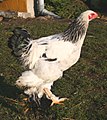User:Billxu0521/sandbox
This article is in the process of being translated from Brahma chicken in the flsc-language Wikipedia. In order to reduce edit conflicts, please consider not editing it while translation is in progress. |
 A Dark Brahma hen. | |
| Other names |
|
|---|---|
| Country of origin | United States of America |
| Traits | |
| Weight |
|
| Egg color | Brown |
| Comb type | Pea |
| Classification | |
| APA | 亞洲 |
| ABA | Feather Legged |
| PCGB | Soft Feather: Heavy[1] |
| |
婆羅門雞是由美國培育出一種大型品種的雞,起初進口於中國上海。婆羅門雞在1850年代到1930年左右是美國的主要肉品種。
History
[edit]

There has been considerable controversy over the origin of the Brahma. It appears to have developed in the United States from very large birds imported from the Chinese port of Shanghai, which were thus known as "Shanghai" birds. It is likely that limited cross-breeding with Chittigong chickens from what is now called Bangladesh gave the Brahma the distinctive characteristics of head shape and the pea comb that distinguish it from the Cochin, another breed that derives from the "Shanghai" birds.[2]
Brahmas were first exported to England in December 1852, when George Burnham sent nine "Gray Shanghaes" to Queen Victoria as a gift.[3] The Dark Brahma variety was developed by English breeders from this stock, and later re-exported to the United States.[2]
The Light and Dark Brahma were included in the first edition of the American Poultry Association's Standard of Perfection in 1874;[2] the Buff variant was added in 1924[2] or 1929.[4]
The Brahma was the principal meat breed in the US from the 1850s until about 1930. Some birds were very large: weights of about 8 kg (18 lb) for cocks and 6 kg (13 lb) for hens were recorded.
Characteristics
[edit]The Brahma is a massive, stately bird, with an upright carriage and a large head. When standing, they should almost appear to form a V, and should stand fairly tall—males more than females. Feet should be strong, with feathers extending all the way down the middle toe, and plumage should be held more tightly than in the Cochin.[citation needed]
Weights average about 5.5 kg (12 lb) for cocks and 4.5 kg (9.9 lb) for hens.[2]
The Brahma is a good winter layer of large brown eggs;[2] eggs weigh approximately 55–60 g.[5]
Recognized varieties
[edit]The American Standard of Perfection recognizes three Brahma varieties: light, dark, and buff. The light Brahma has a base color of white, with black hackles edged in white and a black tail. The cock's saddle feathers in a light Brahma are striped with black. The dark Brahma has the most notable difference between cock and hen. The hen has a dark gray and black penciled coloration with the same hackle as the light whereas the cock has black and white hackles and saddle feathers, and a black base and tail. The wings of a dark Brahma are white-shouldered and the primary feathers (remiges) are edged with white. Buff Brahmas have the same pattern of black as light Brahmas, except with a golden buff base color instead of white.[4]
The Australian Poultry Association has accepted black, blue, partridge, crele and barred varieties of Brahma in addition to the standard light, dark, and buff.[citation needed]
Gallery of varieties
[edit]-
A Light Brahma
-
Buff Brahma
-
Buff Brahma bantam
See also
[edit]References
[edit]- ^ Breed Classification. Poultry Club of Great Britain. Accessed August 2014.
- ^ a b c d e f The American Livestock Breeds Conservatory. "Brahma Chicken".
- ^ George Pickering Burnham (1874). The China Fowl: Shanghae, Cochin, and "Brahma". Melrose, Mass. p. 71.
- ^ a b United States. Agricultural Research Service. Animal Husbandry Research Division (1954). Breeds of chickens for meat and egg production. U.S. Dept. of Agriculture. p. 14–15. Retrieved 25 September 2012.
- ^ Cyril Hrnčár, Monika Hässlerová, Jozef Bujko (2013). The Effect of Oviposition Time on Egg Quality Parameters in Brown Leghorn, Oravka and Brahma Hens. Scientific Papers: Animal Science and Biotechnologies 46 (1).
![]() Media related to Brahma (chicken) at Wikimedia Commons
Media related to Brahma (chicken) at Wikimedia Commons



